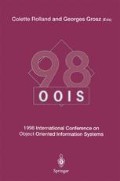Abstract
Most popular object-oriented modeling techniques (OOMTs) provide good support for the creation of structured conceptual models of system behavior and structure. A serious drawback of these techniques is that the concepts and notations used are loosely defined. This can lead to the creation of ambiguous models, and to disagreements over the proper use and interpretation of modeling constructs. An important modeling construct that is often loosely defined is aggregation. In this paper we present a characterization of aggregation that can help developers identify appropriate applications of the concept.
Access this chapter
Tax calculation will be finalised at checkout
Purchases are for personal use only
Preview
Unable to display preview. Download preview PDF.
References
F. Civello. Roles for composite objects in object-oriented analysis and design. OOPSLA, pages 376–393, 1993.
Derek Coleman, Patrick Arnold, Stephanie Bodoff, Chris Dollin, Helena Gilchrist, Fiona Hayes, and Paul Jeremaes. Object-Oriented Development: The Fusion Method. Prentice Hall, Englewood Cliffs, NJ, Object-Oriented Series edition, 1994.
S. Cook and J. Daniels. Designing Object Systems Object Oriented Modelling with Syntropy. Prentice Hall, Englewood Cliffs, NJ, 1994.
The UML Group. Unified Modeling Language, Notation Guide, Ver 1.1, August 1997.
The UML Group. Unified Modeling Language, Semantic Guide, Ver 1.0, January 1997.
H. Kilov and J. Ross. Information Modeling An Object-Oriented Approach. PTR Prentice Hall, Englewood Cilfs, New Jersey, 1994.
A. M. D. Moreira and R. G. Clark. Complex Objects: Aggregates. Technical Report TR CSM-123, Department of Computing Science and Mathematics, University of Stirling, FK9 4LA, Scotland, August 1994.
J. Odell. Six Different Kinds of Composition. Journal of Object Oriented Programming, 6(8):10–15, January 1994.
J. Rumbaugh, M. Blaha, W. Premerlani, F. Eddy, and W. Lorensen. Object-Oriented Modeling and Design. Prentice Hall, 1991.
J. Rumbaugh, M. Blaha, W. Premerlani, F. Eddy, and W. Lorensen. Object Oriented Modeling and Design. Prentice Hall, Englewood Cliffs, New Jersey, 1991.
M. E. Winston, R. Chaffin, and D. Herrman. A Taxonomy of Part-Whole Relations. Cognitive Science, 11:417–444, 1987.
Author information
Authors and Affiliations
Editor information
Editors and Affiliations
Rights and permissions
Copyright information
© 1998 Springer-Verlag London Limited
About this paper
Cite this paper
Saksena, M., France, R.B., Larrondo-Petrie, M.M. (1998). A Characterization of Aggregation. In: Rolland, C., Grosz, G. (eds) OOIS’98. Springer, London. https://doi.org/10.1007/978-1-4471-0895-5_3
Download citation
DOI: https://doi.org/10.1007/978-1-4471-0895-5_3
Publisher Name: Springer, London
Print ISBN: 978-1-85233-046-0
Online ISBN: 978-1-4471-0895-5
eBook Packages: Springer Book Archive

